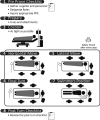Prone positioning for ARDS patients-tips for preparation and use during the COVID-19 pandemic
- PMID: 33367994
- PMCID: PMC7759020
- DOI: 10.1007/s12630-020-01885-0
Prone positioning for ARDS patients-tips for preparation and use during the COVID-19 pandemic
Abstract
Many patients with coronavirus disease (COVID-19) will develop acute respiratory distress syndrome (ARDS). Prone positioning is an important non-pharmacologic strategy that should be considered for all invasively ventilated patients with moderate to severe ARDS (including those with COVID-19). Prone positioning offers several physiologic and clinical benefits, including improving hypoxemia, matching ventilation with perfusion, reducing regional hyperinflation, and improving survival. To safely offer prone positioning, appropriate training, simulation, and health system planning should be undertaken. In this review, we offer ten tips, based on the Alberta provincial prone positioning strategy during COVID-19, to safely implement and improve the appropriate use of prone positioning. We provide special considerations for its use during the COVID-19 pandemic or future respiratory pandemics.
RéSUMé: De nombreux patients atteints de la maladie du coronavirus (COVID-19) développeront un syndrome de détresse respiratoire aiguë (SDRA, ARDS en anglais). Le positionnement ventral est une importante stratégie non pharmacologique qui devrait être envisagée pour tous les patients ventilés de manière invasive et souffrant d’un SDRA modéré à grave (y compris ceux atteints de la COVID-19). Le positionnement ventral offre plusieurs avantages physiologiques et cliniques, notamment l’amélioration de l’hypoxémie, une adéquation de la ventilation avec la perfusion, la réduction de l’hyperinflation régionale et l’amélioration de la survie. Pour offrir un positionnement ventral en toute sécurité, une formation, des simulations et une planification des ressources appropriées devraient être entreprises. Dans le cadre de ce compte rendu, nous proposons dix conseils, fondés sur la stratégie provinciale de positionnement ventral de l’Alberta au cours de la COVID-19, afin de mettre en œuvre et d’améliorer en toute sécurité l’utilisation appropriée du positionnement ventral. Nous décrivons des considérations particulières pour son utilisation pendant la pandémie de COVID-19 ou les futures pandémies respiratoires.
Keywords: COVID-19; acute respiratory distress syndrome (ARDS); mechanical ventilation; prone positioning.
Figures
References
-
- Fan E, Del Sorbo L, Goligher EC, et al. An official American Thoracic Society/European Society of Intensive Care Medicine/Society of Critical Care Medicine Clinical Practice Guideline: Mechanical ventilation in adult patients with acute respiratory distress syndrome. Am J Respir Crit Care Med. 2017;195:1253–1263. doi: 10.1164/rccm.201703-0548ST. - DOI - PubMed
Publication types
MeSH terms
LinkOut - more resources
Full Text Sources
Medical


